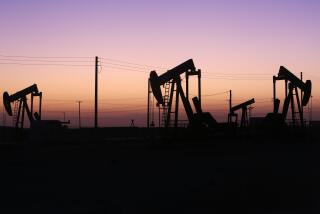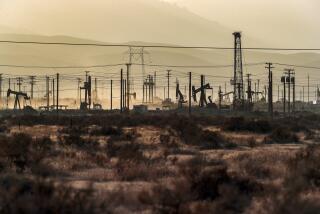BP, Amoco Plan $49-Billion Oil Mega-Merger
The world’s largest industrial merger was announced Tuesday, as energy giants British Petroleum of London and Amoco Corp. of Chicago said they plan to combine in a $49-billion stock deal that could start a gusher of consolidations in the profit-starved oil industry.
Such mergers would reshape the business of searching for oil and natural gas and turning those natural resources into products that consumers use every day.
The new company would be called BP Amoco, and executives expect to save $2 billion a year, partly by eliminating 6,000 jobs, or about 6% of the combined company’s employees.
“This merger is obviously a biggie, and we are going to see new levels of consolidation right at the top. So yes, I think there will be more. There is a desire for size among oil companies to be competitive,” said Sal Ilacqua, energy analyst at Rothschild Inc. in New York.
“By merging our assets and our prospects with those of Amoco, we both secure a leading position in a time of critical change in the oil industry,” John Browne, British Petroleum’s chief executive, told a London news conference.
The average automobile owner would notice little difference at the gasoline pump, particularly in California, where BP and Amoco have few holdings, analysts said.
But the transaction would achieve a host of superlatives: It would create the largest producer of oil and gas in the United States and give British Petroleum, already the industry’s No. 3 investor-owned player, a stronger hold on third place behind only Royal Dutch/Shell and Exxon Corp.
The merger would be the largest industrial combination yet announced, although it lags four bank and telecommunications mergers. The deal would mark the biggest takeover of a U.S. company by a foreign corporation, passing the previous record set by the recent agreement by DaimlerBenz of Germany to buy Detroit-based Chrysler Corp. for $40.5 billion.
The proposed marriage of British Petroleum and Amoco, hailed by analysts as a combination of two complementary companies, pairs Amoco, the largest U.S. natural gas producer and fifth-largest gasoline retailer, with BP, the nation’s largest crude oil producer. The combined entity would be the second-largest gasoline retailer in the nation, with about 16,800 stations.
But there would be little effect on California. None of Amoco’s 9,300 service stations are here; they are spread throughout 33 Midwestern, Eastern and Southern states. BP’s 7,500 stations would slowly be rebranded to Amoco, but that would not include California and 19 states where Connecticut-based Tosco Corp. owns rights to the BP brand. BP once had 220 stations in Northern California but sold them and its Northwestern locations to Tosco, which is in the process of rebranding them all as Union 76 stations.
Amoco’s stock jumped $5.88 to close at $46.88 on the New York Stock Exchange, while BP’s shares rose $2.13 to $78.13.
The deal calls for British Petroleum to exchange 3.97 of its shares for each share of Amoco stock, using a form of security known as American depositary receipts. The tax-free swap values Amoco stock at about $50 a share.
British Petroleum would also assume Amoco’s $4.9 billion of long-term debt.
Analysts expect that the BP-Amoco merger would be far from the last alliance of energy companies--a trend that is being driven by the low profits, high capital costs and intensifying competition in the refining and marketing end of petroleum products. Most oil companies say they derive their biggest profits from offshore oil exploration and development.
BP and Amoco touted the merger as adding $2 billion in annual pretax earnings to the combined entity.
“This sort of restructuring in the oil industry has been talked about almost as much as the summer weather . . . but now it has been achieved,” said Peter D. Sutherland, BP’s chairman.
Some strategic alliances to date have included the sales and refining operations of Shell and Texaco; Marathon and Ashland Oil; and British Petroleum and Mobil in Europe. Unocal sold its gas stations last year to Tosco, which has quietly become one of California’s largest retailers, with more than 1,600 gas stations in the state.
The expectation of more mergers was reflected in big price jumps by oil stocks Tuesday, a day when the rest of the market generally slid.
“This will continue because gasoline consumption is not growing very fast, only 1% to 2% a year, and that low growth tends to drive consolidation,” said Robert A. Hermes, president of Purvin & Gertz energy industry consultants in Houston and Long Beach. Hermes said he doesn’t expect the merger would be felt in California, because of each company’s minimal presence here.
Analysts said the merger would accomplish a number of things. It would create a larger American sales and marketing operation--the second largest in the United States--with a total of 16,800 stations.
With the $2 billion in added pretax earnings, the combined entity would have more capital to devote to more profitable endeavors, such as offshore oil and gas development.
“This merger takes $2 billion in costs out, and that’s nothing to sneeze at,” said Carlos Catoya, energy analyst at Standard & Poor’s in New York. “There have been lackluster returns on all the capital that the companies have invested in refining and marketing. The individual companies have taken out as much cost savings as they could by streamlining their operations or eliminating redundancies.”
Both Amoco and BP are active in exploration and development worldwide, each with important operations in South America. BP will be producing 500,000 barrels of crude a day in Colombia by year’s end.
Amoco is building a $1-billion liquid natural gas facility in Trinidad, where it also has extensive reserves. Amoco also owns half of a massive natural gas field in Bolivia, from which gas is supposed to begin flowing later this year via a pipeline to Brazil.
Amoco has an extensive natural gas production and pipeline network, whereas BP is a strong producer of crude with its Alaskan North Slope stake, producing nearly 500,000 barrels a day, much of which goes to refineries on the West Coast.
Although none are in California, BP owns all or part of 27 refineries in 12 countries.
“This is a kind of rounding-out process for the two companies,” Hermes said.
Amoco produces about 637,000 barrels of crude oil and natural gas liquids a day, and BP turns out 1.25 million barrels a day. Combined, the company would have more than 9 billion barrels of crude reserves and 31 trillion cubic feet of gas.
A merger with BP would allow Amoco to catch up with other U.S. oil companies that have focused away from domestic fields, where oil is becoming more difficult to find and more expensive to pump.
“Amoco has been struggling for a while,” said Bruce Lanni, an analyst with CIBC Oppenheimer. “BP has been growing and looking to grow at a more rapid pace.”
Browne, who would become chief executive of BP Amoco, while Amoco Chairman Larry Fuller and BP Chairman Sutherland would share the job of chairman, said the two companies “do more together than either of us can do separately.”
The deal, which requires approval from shareholders and various regulators, is expected to close by the end of the year.
The transaction represents a family reunion of sorts, rejoining two parts of John D. Rockefeller’s Standard Oil Trust, which was split apart by a 1911 U.S. Supreme Court ruling.
British Petroleum’s pedigree includes Standard Oil Co. of Ohio, Rockefeller’s original company, which it finished buying in 1987. Amoco is the successor to Standard Oil Co. of Indiana, one of the companies created by the breakup of the Standard Oil Trust. The Amoco name was approved by shareholders in 1985.
“John D. Rockefeller probably is whooping it up in his grave,” said Amoco spokesman Dan Dietsch.
Times wire services contributed to this report.






